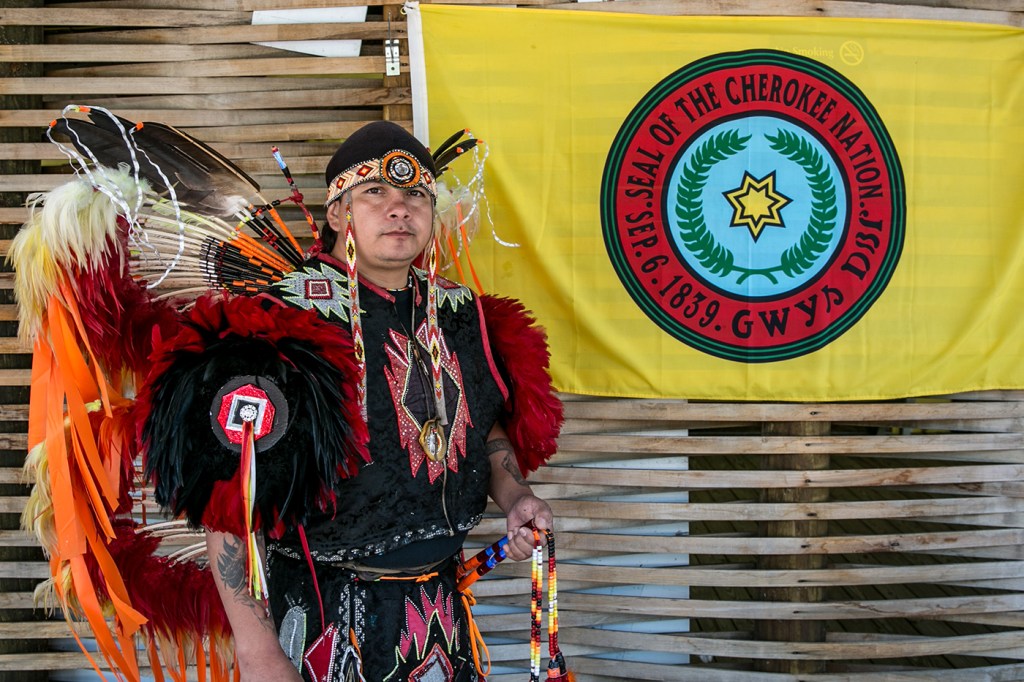Words—and tribal location—matter to citizen of Cherokee Nation

For Ellen Cushman, a citizen of the Cherokee Nation, Native American heritage is about perseverance.
“A heritage of perseverance is common across many indigenous peoples,” Cushman says. “We want to make visible and help people understand that we persevere.”
Given the historical wounds of settlement, displacement, and erasure, Native Americans’ perseverance can vary depending on where they live in relation to where their tribes are located, whether they were removed from their ancestral lands, how many times they were removed, and whether they had boarding school experiences, Cushman says. Native language persistence plays a big role in the Native peoples’ endurance, as well.
Cushman, the dean’s professor of civic sustainability and English in Northeastern’s College of Social Sciences and Humanities, has dedicated much of her career as a rhetoric and literary scholar to researching the Cherokee language and Cherokee identity.

Cushman grew up in upstate New York away from Cherokee speakers. Her family of seven siblings could not afford to visit her Cherokee mother’s relatives in Missouri and Oklahoma often, but Cushman enrolled as a citizen of the tribe with encouragement from her mother as soon as she was old enough to understand what voting meant.
She set out to study the evolution of the Cherokee writing system—the Cherokee syllabary—as an adult, first by reestablishing the connection with the Cherokee Nation. She was able to achieve adequate written proficiency and modest speaking ability by taking classes, studying dictionaries and workbooks and seeking immersion whenever possible.
“The story of the evolution of the Cherokee writing system is an important facet of Cherokee perseverance as a tribe and as a people,” Cushman writes in her book, “The Cherokee Syllabary: Writing the People’s Perseverance” (Oklahoma University Press). “The language is one of four pillars of Native peoplehood: language, history, religion and place. Its loss would spell the ruin of an integral part of Cherokee identity.”
Cherokees are unique in having developed a completely indigenous writing system, Cushman says. The Cherokee syllabary was created by a Cherokee man named Sequoyah who formally introduced his writing system to the Cherokee tribal council in 1821. Within a few years, it became widely used by the tribe.
“It taught us how to read and write in our own language within three to five years without print, without mass school education to do that. We taught each other how to do this,” says Cushman about the syllabary.
Unlike English, Sequoyah’s syllabary doesn’t use letters of the Roman alphabet and seems to show no “logical” connection between the characters and related sounds. Instead, it contains 85 characters that represent the full spectrum of sounds used to speak Cherokee.
Adoption of the writing system allowed Cherokees to unify their tribe, codify their laws and government, and protect their knowledge and perspectives, thus contributing to the tribe’s perseverance.
“It symbolized their intellectual abilities and civilized culture to outsiders, acting as an important indicator of their sophistication,” Cushman writes in her book.
However, Cherokees did not escape the spread of English-only policies and the devastating experience of boarding schools, Cushman says. She has heard stories of ordinary white citizens taking it upon themselves to enforce the use of English by demeaning and beating Cherokee people for speaking their indigenous languages.
It became safer to speak English to avoid beating and harassment, Cushman says. The long history of settlement, displacement, removal and relocation of indigenous people has often had the effect of rendering invisible the histories of Native peoples and languages, she says.
Nowadays, there are more than 400,000 Cherokee Nation citizens, but only about 2,000 of them learned Cherokee as their first language. Several thousands more have been learning the language through the tribe’s language programs, but the COVID–19 pandemic has accelerated the loss of Cherokee speakers.
“Sadly, there are few practical reasons to learn Cherokee,” Cushman says. “Now, at least with Cherokee, it’s all hands on deck to continue with the language persistence efforts and integrate it into our everyday communication.”
As many indigenous languages around the world face a critical situation, UNESCO proclaimed the period between 2022 and 2032 as the International Decade of Indigenous Languages to underscore the need for the continuation of languages, the continuation of being and the perseverance of all indigenous peoples around the globe, Cushman says.
Language persistence depends on people practicing indigenous languages (perseverance) and language documentation (preservation). That is why Cushman has been working with a team of linguists, archivists, software engineers, Cherokee teachers and translation specialists on developing the Digital Archive of Indigenous Language Persistence.
“Right now, we’re trying to develop all of the software and translation practices with Cherokee because Cherokee is well documented and has a written legacy to draw on,” Cushman says.
With some 15,000 historical Cherokee language manuscripts housed in museums and archives around the country to turn to, the team hopes to provide a means for practicing the language with detailed translations and audio recordings.
“That allows scholars and learners, and teachers to go back and really understand the language in meaningful ways,” Cushman says.
The digital archive will include Cherokee stories, speeches, and private letters as well as tribal government documents that show how Cherokees gained the status of a federally recognized tribe. It will also include funeral notices.
“There is a sense of how very difficult it was being born in Indian country between 1925-1946,” Cushman says. “The funeral notices don’t mention the reason for death, but a good number of the funeral notices are for babies or young kids. It’s just staggering.”
The work on DAILP has been sponsored by grants from the National Archives, the National Endowment of the Humanities, the Henry Luce Foundation and others.
To familiarize oneself with and understand the modern indigenous nations, Cushman recommends visiting local tribes that are still in existence in one’s area, like the Mashpee Wampanoag tribe in Massachusetts or Haudenosaunee Confederacy in New York, which consists of six tribes and is described as a model for democracy in the Americas.
“Visiting the nations, getting to know individuals there, learning how they represent their histories, and supporting their artists is a good place to start,” says Cushman, adding that donations are welcomed, too, as tribes are often involved in litigation over land or federal recognition.
Perseverance of Native Americans also depends on visibility of the tribes that are still in existence today, Cushman says.
“The nations continue to have sovereignty over their language, sovereignty over their representations, sovereignty over their cultural practices and their history,” she says.
For media inquiries, please contact media@northeastern.edu.






